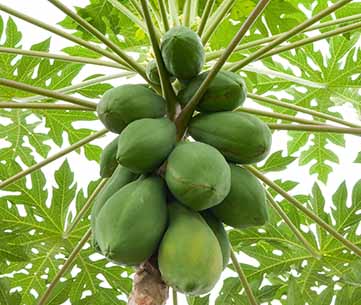
Papaya Australia represents the biosecurity interests of papaya producers and the industry.
Papayas (Carica papaya) are predominately grown in Northern Queensland on the wet tropics of far north Queensland (Innisfail) and the Mareeba district on the Atherton Tablelands west of Cairns. Other growing areas in Queensland include Proserpine and Yarwun in Central Queensland, Gympie and the Sunshine Coast district in SE Queensland. Other commercial production areas include Carnarvon, Kununurra in north Western Australia, the Darwin rural area in the Northern Territory and northern NSW.
Papaya fruit is produced as either red fleshed fruit from hermaphrodite trees, which the industry label as papaya or larger yellow fleshed fruit from dioecious trees which the industry label as pawpaw. Papaya trees have multiple sources of pollination (eg bees, hawkmoths etc) and some cultivars are self-pollinating. Pawpaws make up approximately 60 per cent of the total production with the remainder of production based on red fleshed varieties. The crop is harvested and available all year round and can be purchased nationally from all major supermarkets and smaller independent fruit markets.

Papaya in flower. John M Randall, The Nature Conservancy
The papaya, originating from the tropics of the Americas, is now widely cultivated around the world, particularly in the tropical climates of Asia, Africa and Polynesia. The size and shape of the papaya depends on the variety but most are round, pear-shaped or oval. There are two distinct papaya plant types. Most cultivars are dioecious having both male and female flowers on separate plants and require both plants to produce fruit. However, some are gynodioecious, meaning they have flowers that are either female or bisexual with both male and female parts on the same flower, allowing self-pollination.
For papaya fruit to develop, pollen must be transferred from the staminate (male) flowers to the pistillate (female) flowers. The fruit may produce 1,000 or more seeds and so well over 1,000 pollen grains must be deposited on the stigma while it is receptive. Fruit with less than 300 seeds is usually not marketable, and the more seeds the larger the fruit.

Download the Maximise your Papaya Crop with Better Pollination brochure by Plant and Food Research NZ and Hort Innovation
Hawk moths (Lepidoptera: Sphingidae: Macroglossinae) have been reported as one of the main pollinators of papaya in Queensland where around 94 per cent of Australia’s papaya production occurs.
Several other pollination agents have been suggested in the literature for the more common dioecious varieties including wind, gravity and insects; however, research into honey bees and the importance of their role as pollinators has been somewhat inconclusive. Collectively the research suggests that insects do play a significant role, and that honey bees are capable of improving the pollination and fruit set of most papaya cultivars given their history as an easily managed pollination agent. There is a significant body of earlier research which describes the pollination of papaya by insects, however, results vary as to which insects (if any) are the most important. Some have considered wind to be the primary agent for pollination while others argue a combination of wind and insect pollination is needed for optimal pollination.
Conflicting evidence persists with reference to the pollinating capabilities of honey bees in papaya orchards with more recent research by finding that attractive nectar produced by male flowers around the rudimentary pistal is out of reach of the bees because of the long tube. However, more recent research highlights the importance of insects in general in the pollination of papaya.

Papaya tree bearing fruit. Bigstock
The value of Australian papaya production was estimated at $20 million in 2005–06 season, with $18.4M from Nth Queensland, $1.2M from Western Australia and the Northern Territory and $0.4M from central Queensland and SE Queensland. Industry R,D & E issues are dealt with by the national association Papaya Australia in association with HAL. Papaya growers contribute a levy of 2c/kg for fresh fruit (24c per 12kg carton) for R&D and marketing.
Industry production plummeted (1,036,109 cartons in 2005–06 to 561,377 cartons in 2006–07) following Cyclone Larry in March 2006 which decimated the industry which was then predominately located on the Wet Tropical coast around Innisfail. Atherton Tableland producers quickly responded with increased production and now produce in excess of 50% of the production in far north Queensland. Current production is estimated at around 1.3 million cartons worth approximately $25M per annum. Whilst there are around 80-100 papaya growers, the bulk of production is dominated by a few larger growers.
From a biosecurity perspective, only 17 businesses are registered to move papayas interstate. There are also a number of growers that sell produce in roadside stalls, and many papaya trees are located in backyards across northern Australia.
The above text about pollination is an excerpt from Papaya – Pollination aware fact sheet (2010). Agrifutures Australia Publication No. 10/081
The industry overview and information on the value of production and distribution is from the Industry Biosecurity Plan for the Papaya Industry, Plant Health Australia, Canberra